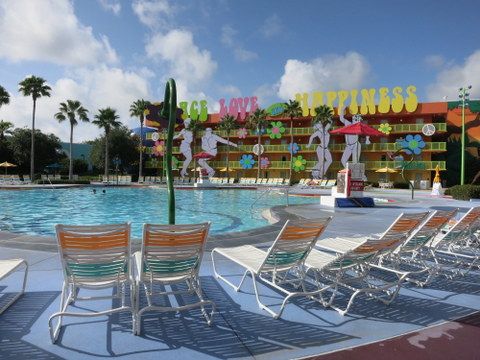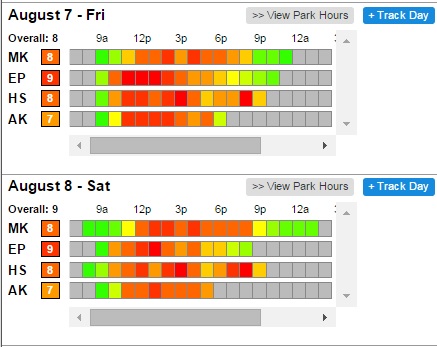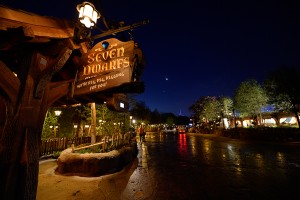
Walt Disney World Planning: Order of Operations
I’ve been helping my middle school-age son with his math homework lately. And one of the things that has been a bit of a challenge is something called “order of operations.” Basically, when you have a complex, multi-step problem, you have to do your calculations in order. Take care of what’s inside of any parentheses first, then calculate any exponents. Next, do your multiplication and division calculations. Finish with any remaining addition and subtraction.
Well, the same principle applies to planning a Walt Disney World vacation, which is its own complex, multi-step problem. So consider this a step-by-step road map that will keep you on course and allow you to reach the correct solution: a successful Disney vacation. If you’re new to planning, I highly recommend using the services of a travel agent that specializes in Disney destinations. They can help guide you and answer any questions you might have along the way.
Parentheses (first things first)
Let’s assume you’ve already decided on a Walt Disney World vacation. Consider this step the parentheses of our equation: the one part you simplify and solve before anything else. The first crucial decisions in your planning are when and where you’re going to stay.

It’s good to first take a step back and decide what expectations you and your traveling companions have for this vacation. Is it a shorter “commando” trip where you’re spending the vast majority of your time in the parks, only returning to your room to sleep and shower? In this case, a Value or Moderate Resort, providing the essentials, but keeping you on property, could fit the bill.
Or maybe it’s a more leisurely trip where restful time at the resort is a prime goal. In this case a Deluxe Resort like the Animal Kingdom Lodge provides plenty to do at a lower price than the Monorail resorts, where you’re paying a premium for the location. You might consider Saratoga Springs Resort and Spa if you want to spend a lot of time in Disney Springs.
Perhaps you’re a larger group with extended family coming along for the ride. Grand Villas at Deluxe Villa Resorts can accommodate up to 12 guests. Really large families may want to consider renting a nearby vacation homes. If staying on property is essential, expand options even more by booking multiple standard rooms at a chosen resort.
Do you have a short window of time for your trip, or are you more flexible with your dates? Using the Touring Plans Crowd Calendar can tell you the least crowded times to travel (which are often the cheapest). Are you targeting a particular event or season? If you’re all about the Epcot International Food & Wine Festival, then you might be happiest with a room at one of the Crescent Lake resorts.
I find that any upcoming trip is somewhat nebulous until you get your destination resort into focus. As we will see, having a handle on where you’ll be staying will help the next planning steps fall into place.
Getting to the (square) root of transportation and tickets
You have your resort, but how are you getting there? Are you flying into Orlando, or loading up the car and driving yourself?
If you have your own car, that simplifies the transportation picture fairly quickly. You can rely on your own car instead of taking Disney transportation. If you’re staying off property, however, you’ll have to factor that $20 per day it will cost you to park at the theme parks.

Those flying into Orlando International Airport will have a bit more calculating to do. The big question is whether or not to rent a car. My general advice for first-time or less experienced WDW travelers is that Disney transportation, including Disney’s Magical Express to and from the airport, is a good option and gives you one less thing to worry about. The more experienced may want to opt for a rental car, which can save time getting around the resort. A rental car also gives you the option of heading off property for supplies, dining or other attractions. More recently, the arrival of Uber on Walt Disney World property provides one more option in between a rental car and being completely reliant on Disney transportation.
Along with transportation, a key consideration is the type of ticket and number of admission days. Often, when Walt Disney World has a special offer, it’s for packages, which means you’re required to purchase park tickets along with your resort reservation.
The general rule for tickets is that if you’re at the 4-day mark, adding days is around $15 or less per day. So if you have enough time on your departure day to spend a few hours in the parks, add a day. As far as Park Hopper goes, that’s a personal preference and depends on how you tour the parks. If you’re already paying for a Monorail or Epcot resort, a Park Hopper is a no-brainer. It allows you to leverage your easy access to a nearby park.
Pro tip: Unlike actual math equations, you can delay the order of your ticket operation. You can add a Park Hopper, Water Parks Fun & More or additional days to your existing ticket during your trip, as long as you have remaining admissions on it and you’re within 14 days of first use.
Handle multiple ADRs by dividing your days
One of the steps that can cause vacation planners to break out in a cold sweat is the pressure of booking an entire vacation’s worth of dining 180 days in advance. Now that we’re in the multiplication and division portion of our equation, we can ease our multiplying stress by first dividing up the days of our trip.

Thanks to our previous step, we already know how many park days we have. Now, it’s a matter of picking the number of days we want to spend in each park and then arranging them in an ideal order. Once again, a key tool for us is the Touring Plans Crowd Calendar to help us pick those days. Some go strictly by recommended parks with the least crowds. Others may want to target parks with Extra Magic Hours to maximize their use of the parks. It can be a bit of a jigsaw puzzle, but getting your day-by-day park itinerary in order will help the rest of your plans fall into place.
With your park calendar finished, as in math, you’ll work from left to right, picking restaurants that line up with your planned park for each day. Keep in mind that if you’re staying on property, you can book reservations for your entire trip, up to 10 days, 180 days from the start of your resort stay.
When making Advance Dining Reservations, rather than going in order of your trip, prioritize those that fill up the quickest, like Be Our Guest, Cinderella’s Royal Table, Le Cellier and Chef Mickey’s. Also, if you’re trying for a specific time, say a reservation at California Grill to view fireworks, make that reservation before filling in the rest of your ADRs.
This is an area where the stress can be greatly lessened by using a Disney travel specialist. Let the expert get those ADRs locked in for you as you relax and dream about all the great food you’ll be enjoying.
Addition, as in FastPass+
You’ve made it this far. You’re almost to the end of what once looked to be a daunting problem to solve. We’re now at the addition and subtraction part of our equation, in this case, making our FastPass+ reservations. Now that you know which park you’ll be in, and when you’ll be eating, you can fill out your park days by booking your attractions.

Similar to dining reservations, guests staying at a Disney resort enjoy a 60-day window when their FastPass+ availability opens. Guests off property can only book their three FastPasses per day 30 days in advance. The 60-day window is a big advantage when it comes to booking the hot, new attractions. So get Seven Dwarfs Mine Train and Frozen Ever After locked in right away. If you’re heading to Walt Disney World later this summer, you’ll likely have to add the banshee flight simulator in Animal Kingdom’s new Pandora land to that list.
After your priority FastPasses, you can fill in your with other high-demand attractions. It’s a good strategy, particularly for Magic Kingdom, to bunch your FastPasses in the morning, one after the other. This way you can get to book your fourth FastPass earlier in the day. Remember, as soon as you tap your Magic Band for your third attraction, you can make your fourth FastPass reservation. Thanks to enhancements to the My Disney Experience app, you can take care of it on your phone. No need to go to a kiosk.
With resort, ticket and transportation details set and your dining reservations and FastPasses booked, you can consider your vacation planning equation solved. Well done!
Robert Blaszkiewicz is on Twitter @RobertBlaszk and Facebook.






PEMDAS, let’s see how this applies to WDW:
P – Plan what time of year to visit
E – Explore all the changes WDW has made since your last visit
M – Mark your 180+ & 60+/30 day windows and set alarms
D – Deposit a huge chunk of your retirement savings on a Magic Your Way package
A – Arrive in Orlando
S – Sip a Mojito, or your fuel of choice
Yep! Works like a charm ;^)
I knew paying attention in math class would come in handy!
I like the way you think, Heather!
I would add the step of building your touring plans between the ADRs and FP+ reservations. It’s a crucial step for minimizing the amount of time spent waiting in line – plus you always have an idea of what you want to do next (i.e eliminating the “uhh I dunno, what do you want to do next?” conversation).
He mentions staying off site in booking resorts section and FP are made 30 days prior to trip. What tips were you looking for just off-site guests?
It’s not that we personally are looking for tips (although we’d be happy to learn new ones we don’t know). My complaint is that almost every TouringPlans article tacitly assumes guests will be staying on-site, and are written from that point of view. Mostly, as with this article, things that off-site guests need to know are mentioned in passing.
And to be clear, I wasn’t trying to be “harsh”. I just wonder why the two alternatives are not treated equally. Based on the number of on-site rooms, room occupancy rates, and attendance figures, about 1/3-1/2 of all wdw guests do not stay on-site. That’s a pretty big market to essentially ignore.
I appreciate the spirit in which your feedback was given. I did try to include differences for off-site guests in this post, but in the future, I’ll definitely keep in mind that those staying off site aren’t ignored. I appreciate you reading and sharing your thoughts!
The readers of this site are so harsh. I thought this was a fun, entertaining article. It wasn’t meant to cover every possible scenario.
A good article, but yet again it (mostly) assumes guests will be staying on-site. A common failing of most TouringPlans blog entries. Many of us don’t (and not because we’re local… we just choose not to give Disney the exorbitant amount of money they want for a decent room).
Great article but can’t you book ADRs 190 days in advance if you are staying on property?
Yes, and he says that in the article.
“Keep in mind that if you’re staying on property, you can book reservations for your entire trip, up to 10 days, 180 days from the start of your resort stay.”
Oops missed that in the article – sorry – I am putting it down to the fact that, as many of us in the U.K., I am suffering from the same heavy cold the Queen had. Apparently it lasts 4 weeks and I am on day 3 🙁 Could do with a holiday – somewhere warm (compared to the snow we are having). Might look for something in about 25 days time…. Now let me reread this article and get planning.
This is all great, and definitely the right order to figure things out in. There’s a key caveat, though, that’s completely unmentioned in the article: restaurant reservations are totally optional. You can have a magical, fulfilling, complete WDW vacation without ever setting foot in a table-service restaurant. For someone’s who’s never been there and is relying on an article like this for guidance, the instruction that they should “work from left to right, picking restaurants that line up with [their] planned park for each day” falsely implies that they need to make one or more ADRs for EACH DAY.
Thanks Andy. You’re absolutely right. My thinking is that your average guest may be doing the dining plan, but I should have included that caveat. There are others who do multiple table services in a day. So I should have better reflected the spectrum of choices.